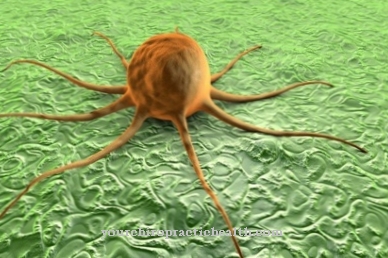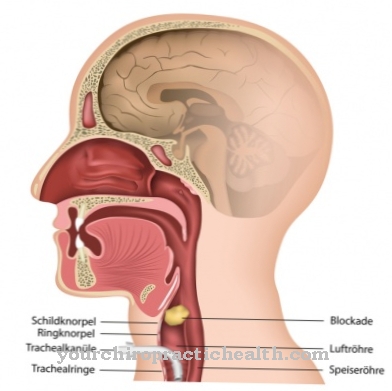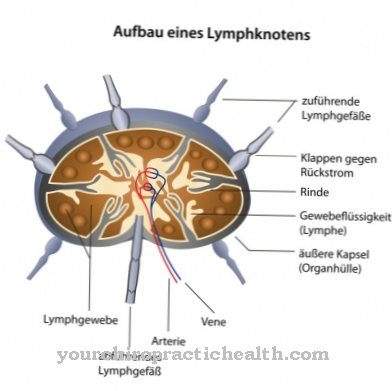A Oligodendroglioma is a brain tumor that develops from so-called oligodendrocytes, especially in the cerebrum. Oligodendrocytes produce the fatty shell of nerve cells. The average age at diagnosis of oligodendroglioma is 35 years.
What is an oligodendroglioma?

Tumors that affect the central nervous system (CNS) are rather rare. About 5 percent of these disorders will have one Oligodendroglioma diagnosed. These types of brain tumors are more common in adults (9.4% of all primary brain tumors) than in children (4%).
An oligodendroglioma forms in particular in the frontal or temporal lobes, i.e. the frontal lobes, parietal lobes and occipital lobes. Referring to the observation of the tumor under a microscope, the disease is divided into two types: a well-differentiated oligodendroglioma that grows slowly (Class II) and an anaplastic, faster-growing oligodendroglioma (Class III).
An oligodendroglioma in the frontal lobe of the brain can lead to gradual changes in mood and personality, but also to unilateral inability to move (hemiparesis). Problems with coordination and language or memory can be due to an oligodendroglioma in the temporal lobes of the brain.
causes
As with most brain tumors, the cause is one Oligodendroglioma largely unknown. The central nervous system (CNS) consists of the brain and spinal cord. The cells in the CNS normally grow in an orderly, controlled manner.
If this order is disturbed for any reason, the cells begin to divide and form a lump or tumor. In the brain there are nerve cells and cells that protect the nerve cells. These supporting cells are called glial cells. A tumor that develops there is called a glioma.
Like other tumors, an oligodendroglioma is either benign or malignant. Benign tumors can continue to grow without interfering with normal cell growth. A malignant oligodendroglioma will invade cells, destroy surrounding tissue, and spread to other areas of the brain.
Symptoms, ailments & signs
The symptoms of an oligodendroglioma are mainly characterized by displacement and compression processes in neighboring brain structures due to tumor growth. Typically there are general signs of intracranial pressure and focal deficits. As part of the intracranial pressure signs, nausea, vomiting, loss of appetite, tiredness, headache, attention disorders or restlessness occur.
In pronounced cases, the triad of symptoms of high blood pressure, reduced heart rate and shortness of breath is observed. Epileptic seizures or strokes are also very typical of an oligodendroglioma. The strokes are due to the fact that the tumors have a tendency to bleed in. Edema (perifocal edema) can form around the tumor, which in turn leads to additional masses.
Under certain circumstances, there is also an obstruction of the liquor drainage. The resulting accumulation of cerebral fluid also leads to the displacement of brain tissue. This can increase intracranial pressure signs, headaches, vomiting and seizures. Without treatment, life-threatening brainstem entrapment is possible. However, not every person affected develops the same symptoms.
Symptoms depend on which areas of the brain are affected and how the tumor behaves. The speed of growth, the ability to infiltrate and the risk of metastasis can differ from one another in the various tumors. While in many tumors the symptoms caused by compression processes are in the foreground and are crucial for survival, other symptoms can predominate if metastases develop prematurely.
Diagnosis & course
Affected people with a slow growing Oligodendroglioma may develop mild symptoms for several years before the tumor is discovered. The first symptoms of any type of brain tumor usually develop due to increased pressure within the skull (increased intracranial pressure) that can be caused by the oligodendroglioma.
This leads to headache, nausea (vomiting) and blurred vision. With further progression of the disease it can lead to convulsive seizures, in up to 80% of the cases mainly to changes of the personality. The diagnosis is aimed at gaining the most comprehensive information possible about the oligodendroglioma.
Simple reflex tests and an anophthalmoscopy (examination of the back of the eye) initiate further examinations using computed tomography or magnetic resonance tomography. An oligodendroglioma can only be unequivocally diagnosed through a histopathological examination (biopsy).
Complications
Since oligodendroglioma is a tumor in the brain, it comes with the usual symptoms and complications of cancer. The further course of the disease depends very much on the time of diagnosis. In most cases, those affected suffer from severe headaches and epileptic seizures. Visual disturbances or nausea can also occur and are often associated with vomiting.
Because of the oligodendroglioma, those affected also suffer from disorders of consciousness and, in many cases, from personality changes. Furthermore, there is forgetfulness and general memory disorders. Most patients feel uncomfortable in everyday life and suffer from a general feeling of illness. The quality of life of the person affected is significantly restricted and also reduced by the oligodendroglioma.
In many cases there is also depression or other psychological upsets. With the help of surgical interventions and other methods, oligodendroglioma can be partially treated. However, complete healing does not occur, so that in most cases those affected also have a significantly reduced life expectancy.
When should you go to the doctor?
As a brain tumor, the oligodendroglioma belongs in medical diagnosis and therapy. There are a number of reasons that require a doctor's visit in this context. This includes the suspicion of a brain tumor as well as side effects of therapies or the consistent adherence to follow-up appointments.
Suspected brain tumor activity can arise from sensory disturbances, paralysis or headaches. However, these symptoms are so unspecific that they cannot be clearly assigned to a brain tumor such as oligodendroglioma, but can have a number of other reasons. The first point of contact is therefore the family doctor in this context. If necessary, he will refer you to physicians from other specialties such as radiologists or neurologists.
During or after the treatment of an oligodendroglioma, side effects can occur that require a doctor's visit. Surgery, chemotherapy and radiation therapy put a strain on the body and complications such as secondary bleeding must be ruled out, as well as changes in the blood count, which can lead to serious consequences. The psyche is also a reason for visiting the doctor if a patient cannot cope with the stressful diagnosis. A referral to a psychologist or psycho-oncologist can be useful here.
Follow-up care is also important and linked to appropriate appointments with the doctor. Here it is important not only to follow up the follow-up appointments consistently, but also to always consult the doctor if unusual, strong or long-lasting symptoms occur.
Treatment & Therapy
A Oligodendroglioma is considered incurable according to the current medical status. Studies have shown that with aggressive treatment and close monitoring, it is possible to increase life expectancy. How an oligodendroglioma is treated depends on general health, the anatomy of the tumor, and the spread of cancer cells.
Treatment is usually carried out by a multidisciplinary team of specialists. Before an oligodendroglioma is treated surgically, medicinal measures are often initiated to lower the pressure in the skull. The aim of a surgical procedure is to remove the tumor without damaging the surrounding brain tissue.
Due to its diffuse infiltrating nature, an oligodendroglioma cannot be completely eliminated and cannot be cured by surgery alone. Therefore, other treatment methods are used. In radiation therapy, high-energy rays are used to destroy cancer cells. It is usually an external treatment method, but a small radioactive implant may also be used.
An oligodendroglioma can be accompanied by surgery or radiation with chemotherapy, i.e. Use cytotoxic drugs to be treated.
Outlook & forecast
The prognosis for oligodendroglioma is better compared to other brain tumors. Some of the oligodendrogliomas grow slowly. Therefore, the prognosis is significantly better than with fast-growing and malignant oligodendrogliomas.
The prognosis depends, among other things, on the nature of the tumor cells. If you have a well-differentiated, low-grade oligodendroglioma, the outlook is significantly better than if you have an anaplastic, high-grade oligodendroglioma with severely degenerated cells.
There is no cure for oligodendroglioma. The prognosis is about estimating the survival time. With the help of appropriate therapeutic measures, patients can survive a slowly growing oligodendroglioma for ten years or more. In the case of a high-grade, anaplastic oligodendroglioma, it is only a few months. These prognoses have to be considered with caution because other parameters influence the survival time.
This includes the general health condition, age, the exact location of the tumor or its size. The therapy and the question of how it works also influences the prognosis. The formation of metastases can occur postoperatively or in the case of higher-grade oligodendrogliomas.
On average, cancer specialists expect a survival time of five years for low-grade oligodendrogliomas for 74 percent of those affected. 46 percent of those affected survive longer. With highly malignant oligodendrogliomas, the survival rates are significantly lower.
prevention
As the causes of brain tumors like one Oligodendroglioma are largely unknown, no preventive measures can be taken. Even with oligodendroglioma, dealing with cancer affects the entire personal environment of the patient and often requires a significant change in lifestyle.
Aftercare
Oligodendroglioma is a brain tumor that requires consistent follow-up care after therapy.This also depends on where the tumor was located and what size it was, whether it caused deficiency symptoms and how it was treated. What all tumors have in common, however, is that the patient needs close monitoring so that any new tumor growth can be recognized early and adequately treated.
The physical aftercare concentrates on the one hand on regeneration after a strenuous treatment phase, on the other hand on failure symptoms or other problems as a result of the tumor. Often the person concerned learns individually suitable exercises as part of speech therapy, occupational therapy or physiotherapy, which can then be practiced consistently at home. The consequences of radiation and chemotherapy can often be coped with through a healthy lifestyle. Excessive alcohol consumption and especially nicotine should be avoided here.
Psychological follow-up is also important in order to be able to process the diagnosis of brain cancer and the fear of relapse. Talking to family and friends can be just as helpful in this context as visiting an oncological self-help group. Relaxation techniques can also be helpful. Jacobsen's progressive muscle relaxation is at the same time gentle motor training. Yoga also calms you down through the combination of body, breathing and relaxation exercises.
You can do that yourself
As a brain tumor, oligodendroglioma should always be treated by a specialist, but there are also some things that patients can do in everyday life as part of self-help. This everyday help can be divided into the physical and the mental-emotional area.
In the physical area, motor skills are often restricted by the tumor itself or an operation. Here, physiotherapists or occupational therapists often teach exercises that the patient can do independently at home. In addition to the exercises for these local restrictions, there are also opportunities to improve the overall condition of the patient, especially after radiation or chemotherapy. This includes a healthy diet and sufficient amounts of water to drink as well as controlled exercise, which is possible either at home or at a sports club, but also in special rehabilitation courses. Shortening and tension in the muscles can be loosened with the help of massages.
The mental and spiritual condition can also be positively influenced by self-help. On the one hand, this applies to cognitive skills: Perception and memory, like language, can be trained through suitable exercises. In the psychological area, the person concerned is often bothered by the thought of the brain tumor. Conversations with relatives, friends or in self-group groups help here. Methods such as Jacobsen's progressive muscle relaxation, autogenic training or yoga ensure relaxation.

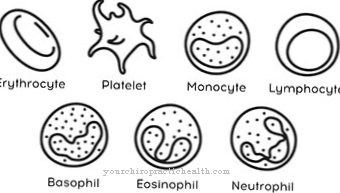
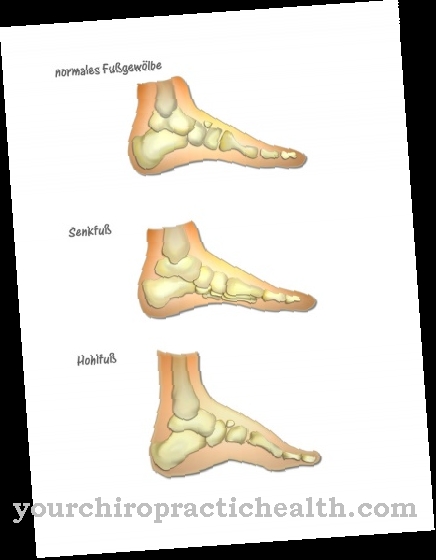
.jpg)











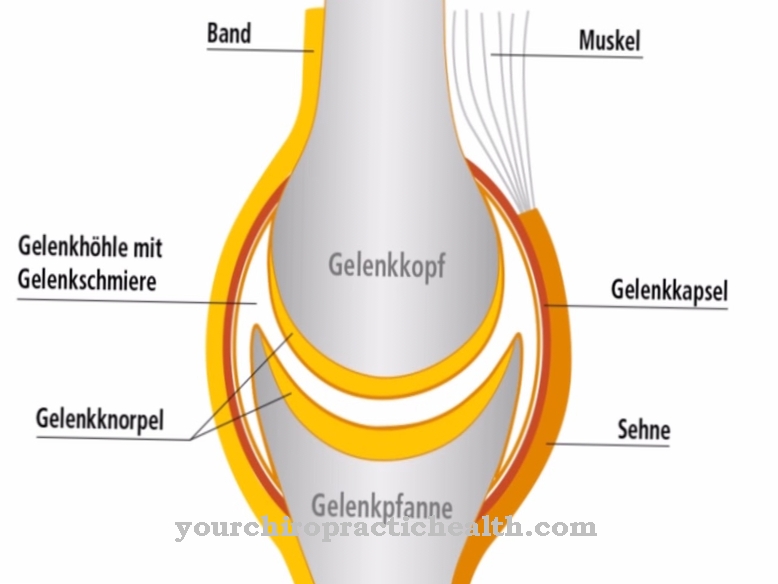
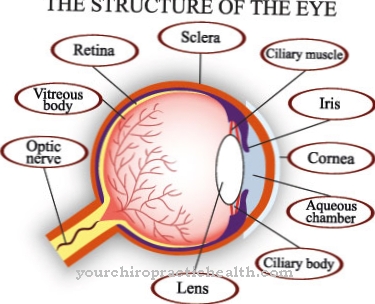



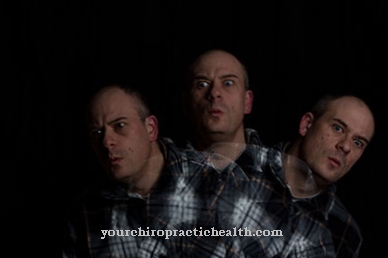

.jpg)
